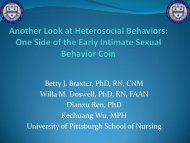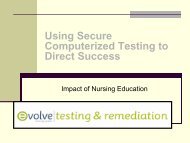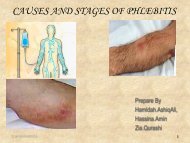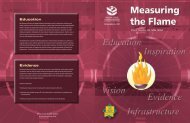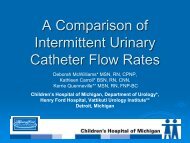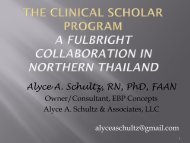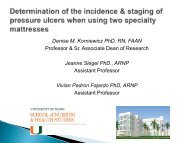Curt B. Haase, BSN, RN, OCN® - IUPUI
Curt B. Haase, BSN, RN, OCN® - IUPUI
Curt B. Haase, BSN, RN, OCN® - IUPUI
Create successful ePaper yourself
Turn your PDF publications into a flip-book with our unique Google optimized e-Paper software.
Reeducation of Acupressure for<br />
Chemotherapy-Induced Nausea & Vomiting<br />
<strong>Curt</strong> B. <strong>Haase</strong>, <strong>BSN</strong>, <strong>RN</strong>, OCN®<br />
Memorial Sloan-Kettering Cancer Center<br />
New York, NY, USA
• Objectives & Research Question<br />
• Chemotherapy-Induced Nausea & Vomiting<br />
• Acupressure<br />
• Initial Education of Nursing Team<br />
• Intervention: Assessment of Acupressure Use<br />
• Next Steps: Reeducation
• Discuss the safe, well-tolerated, low-cost,<br />
effective nature of acupressure for<br />
chemotherapy-induced nausea & vomiting.<br />
• State the importance of reeducation of staff<br />
to ensure appropriate, evidence-based<br />
interventions for patients.
• Among nurses who treat patients receiving<br />
chemotherapy, how often is Acupressure for<br />
Chemotherapy-Induced Nausea and<br />
Vomiting used? What are the barriers to<br />
implementation?
• Nausea and Vomiting are some of the most<br />
upsetting side effects<br />
• Experienced by 70-80% of chemotherapy<br />
patients over the course of treatment<br />
(Chao et al., 2009; Lee, Dibble, Dodd, Abrams, & Burns, 2010; Taspinar & Sirin, 2010)
• Typical management is with pharmacologic<br />
antiemetics<br />
• Not completely effective<br />
• Undesirable side effects<br />
• Main reasons to not follow chemotherapy treatment<br />
schedule<br />
• Financial cost<br />
(Chao et al., 2009; Lee, Dibble, Dodd, Abrams, & Burns, 2010; Taspinar & Sirin, 2010)
(Figueroa-Moseley et al., 2007)
Acupressure<br />
•Based on<br />
Acupuncture &<br />
Meridians<br />
•Traditional Chinese<br />
Medicine<br />
•More than 5,000<br />
years old<br />
Image Used with Permission.
Acupressure<br />
•Stimulation of an<br />
acupoint with a finger<br />
•Acupoints can help<br />
release tension,<br />
promote blood<br />
circulation, and relieve<br />
side effects<br />
Image Used with Permission.
• Mechanism of Action<br />
• Unclear<br />
• Thought to release beta-endorphins to the cerebrospinal<br />
fluid and change serotonin transmission<br />
• Preventing the activation of the 5-HT 3 chemoreceptors<br />
in the GI tract and in the medullary vomiting center<br />
(Nunley, Wakim, & Guinn, 2008)
• Safe<br />
• Low-cost<br />
• Convenient<br />
• Easy-to-learn<br />
• Effectively prevents CINV across populations, ages,<br />
and cancer diagnoses<br />
• Minimal to no side effects!!<br />
(Figuertoa-Moseley et al., 2007; Gardani et al., 2007; Jones et al., 2008; Roscoe et al., 2009; Roscoe et al., 2010; Taspinar & Sirin, 2010)
• Acute nausea<br />
• Delayed nausea<br />
• Anticipatory nausea<br />
(Ezzo et al., 2006; Gardani et al., 2007; Taspinar & Sirin, 2010)
• Acute nausea: nausea within 24 hours of treatment<br />
• Reduction of nausea severity and mean nausea scores<br />
• Lowest efficacy seen when used during anthracyclinecontaining<br />
regimen<br />
• Increased efficacy with other chemotherapies<br />
(Ezzo et al., 2006; Gardani et al., 2007; Taspinar & Sirin, 2010)
• Delayed nausea: nausea after the first 24 hours of<br />
treatment<br />
• Difficult to manage, especially day 3 post-treatment<br />
• Even with acupressure, there is a peak level of nausea<br />
at day 3<br />
• Can delay addition of neurokinin-1 receptor<br />
antagonists (aprepitant)<br />
(Gardani et al., 2007; Lee et al., 2008; Lee et al., 2010; Taspinar & Sirin, 2010)
• Anticipatory nausea: the expectation of a unpleasant<br />
experience<br />
• Difficult to treat because patient anxiety is increased<br />
• Best to prevent nausea from the beginning<br />
• Acupressure with standard treatment yields<br />
significantly less anticipatory nausea, but only for the<br />
first 2 cycles<br />
• Expectation plays an important role<br />
(Figueroa-Moseley et al., 2007; Roscoe et al., 2010)
Pericardium 6 (P6, PC6)<br />
Stomach 36 (ST36)
Pericardium 6 (P6, PC6)<br />
Nèi guān<br />
“Inner Gate”<br />
內 關<br />
• Easily accessible!
Locating<br />
P6<br />
3 finger-widths<br />
below the<br />
hand crease,<br />
between the<br />
flexor tendons.
Locating<br />
P6<br />
Apply firm<br />
pressure in a<br />
circular<br />
motion.<br />
Should not be<br />
discomforting.
P6 Patient<br />
Education<br />
3 finger-widths<br />
below the<br />
hand crease,<br />
between the<br />
flexor tendons.
P6 Return<br />
Demonstration<br />
Apply firm<br />
pressure in a<br />
circular<br />
motion.<br />
Should not be<br />
discomforting.
P6 Return<br />
Demonstration
• Before meals and at bedtime for 2-3 minutes, and as<br />
needed<br />
• Every 2 hours for 3-5 days after treatment<br />
• Continuous for 3-5 days, with<br />
wristbands<br />
(Gardani et al., 2007; Lee et al., 2008; Lee et al., 2010; Taspinar & Sirin, 2010)
• December 2009<br />
• Gastrointestinal Chemotherapy Suite<br />
• 16 Chemotherapy Nurses<br />
• In-service by Integrative Medicine Staff<br />
• Patient Information Fact Card Development and Use
• One Year Later… “How Are We Doing?”<br />
• Intervention: Survey to Gastrointestinal<br />
Chemotherapy Suite Nurses in December 2010
• Acupressure education.<br />
• Number of patients in the month prior that they spoke<br />
with about acupressure.<br />
• Reasons that prevented the nurse from offering.<br />
• Perceived barriers from patients.<br />
• Other interventions offered.<br />
• Suggestions to help to promote acupressure to patients.
• 19 Nurses completed survey.<br />
• 58% of those were not acupressure educated.<br />
• Only 38% of acupressure-educated nurses<br />
surveyed offer acupressure to patients.
Forgot<br />
No Time/<br />
Busy Day<br />
Did Not<br />
Understand It<br />
My Patients<br />
Aren’t<br />
Interested<br />
Not<br />
Comfortable<br />
Explaining<br />
“I Don’t<br />
Think It<br />
Works”
Did Not<br />
Understand<br />
Did Not<br />
Know<br />
About It<br />
No Perceived<br />
Need/Benefit<br />
No Time<br />
Not<br />
Interested<br />
Unpleasant<br />
Past<br />
Experience
• Identified by Chemotherapy Nurses<br />
• “It helps when patients are open to it.”<br />
• Time was needed to explain and perform<br />
procedure well.<br />
• Fact Cards need to be displayed on the unit.
• Reinforce the original in-services.<br />
• Some nurses missed the in-services.<br />
• New nurses have joined the team.<br />
• 88% of nurses not previously educated are<br />
interested in learning.
• Give nurses better understanding and increased<br />
comfort level<br />
• Reeducation of all chemotherapy nurses is<br />
needed to overcome barriers
• Can reduce pharmacologic antiemetic use<br />
• Delay addition of 5-HT3 antagonist (ondansetron)<br />
and/or NK-1 receptor antagonist (aprepitant)<br />
• Reduce cost and side effects<br />
• More convenient<br />
(Chao et al., 2009)
• Stress the safety, efficacy, and simplicity<br />
• Relieves anxiety<br />
• Every patient, every chemo visit<br />
• At treatment and at home<br />
(Chao et al., 2009)
Chao, L.-F., Zhang, A. L., Liu, H.-E., Cheng, M.-H., Lam, H.-B., & Lo, S. K.<br />
(2009). The efficacy of acupoint stimulation for the management of therapyrelated<br />
adverse events in patients with breast cancer: A systematic review.<br />
Breast Cancer Res Treat, 118, 255-267. doi:10.1007/s10549-009-0533-8<br />
Ezzo, J., Richardson, M. A., Vickers, A., Allen, C., Dibble, S., Issell, B. F., …<br />
Zhang, G. Acupuncture-point stimulation for chemotherapy-induced nausea<br />
or vomiting. Cochrane Database of Systematic Reviews 2006, Issue 2. Art No.<br />
:CD002285. doi:10.1002/14651858.CD002285.pub2.<br />
Figueroa-Moseley, C., Jean-Pierre, P., Roscoe, J. A., Ryan, J. L., Kohli, S., Palesh,<br />
O. G., et al. (2007). Behavioral interventions in treating anticipatory nausea<br />
and vomiting. J Nat Compr Cancer Network , 5(1), 44-50.<br />
Gardani, G., Cerrone, R., Biella, C., Galbiati, G., Proserpio, E., Casiraghi, M., et<br />
al. (2007). A progress study of 100 cancer patients treated by acupressure for<br />
chemotherapy-induced vomiting after failure with the pharmacological<br />
approach. Minerva Medica , 98(6), 665-8.
Jones, E., Isom, S., Kemper, K. J., & McLean, T. W. (2008). Acupressure for<br />
chemotherapy-associated nausea and vomiting in children. J Soc Integr<br />
Oncol, 6(4), 141-145. doi:10.2310/7200.2008.0023<br />
Lee, J., Dibble, S., Dodd, M., Abrams, D., & Burns, B. (2010). The relationship of<br />
chemotherapy-induced nausea to the frequency of pericardium 6 digital<br />
acupressure. Oncol Nur Forum, 37(6), E419-E425. doi:10.1188/10.ONF.E419-<br />
E425<br />
Lee, J., Dodd, M., Dibble, S., & Abrams, D. (2008). Review of acupressure studies<br />
for chemotherapy-induced nausea and vomiting control. J Pain Symptom<br />
Manage , 36(5), 529-544. doi:10.1016/j.jpainsymman.2007.10.019<br />
Nunley, C., Wakim, J., & Guinn, C. (2008). The effects of stimulation of<br />
acupressure point P6 on postoperative nausea and vomiting: A review of<br />
literature. J Peri Anesth Nurs , 23(4), 247-261. doi:10.1016/j.jopan.2008.05.001
Roscoe, J. A., Bushunow, P., Jean-Pierre, P., Heckler, C. E., Purnell, J. Q.,<br />
Peppone, L. J., … Morrow, G. R. (2009). Acupressure bands are effective in<br />
reducing radiation therapy-related nausea. J Pain Symptom Manage , 38(3),<br />
381-389. doi:10.1016/j.jpainsymman.2008.09.006<br />
Roscoe, J. A., O'Neill, M., Jean-Pierre, P., Heckler, C. E., Kaptchuk, T. J.,<br />
Bushunow, P., … Smith, B. (2010). An exploratory study on the effects of an<br />
expectancy manipulation on chemotherapy-related nausea. J Pain Symptom<br />
Manage , 40(3), 379-390. doi:10.1016/j.jpainsymman.2009.12.024<br />
Taspinar, A. & Sirin, A. (2010). Effect of acupressure on chemotherapy-induced<br />
nausea and vomiting on gynecological cancer patients in Turkey. Eur J Oncol<br />
Nurs , 14, 49-54. doi:10.1016/j.ejon.2009.07.006
Cathy Cruz<br />
Lourdes Diaz<br />
Donna Fade<br />
Jeanine Gordon<br />
Purnima Persaud<br />
Suzanne Stamile<br />
Rori Salvaggio<br />
GI Chemotherapy Suite Staff<br />
Denise Stone<br />
Yi Chan<br />
Bendheim Integrative Medicine Center Staff<br />
Jon Themann
Reeducation of Acupressure for<br />
Chemotherapy-Induced Nausea & Vomiting<br />
<strong>Curt</strong> B. <strong>Haase</strong>, <strong>BSN</strong>, <strong>RN</strong>, OCN®<br />
haasec @ mskcc.org



